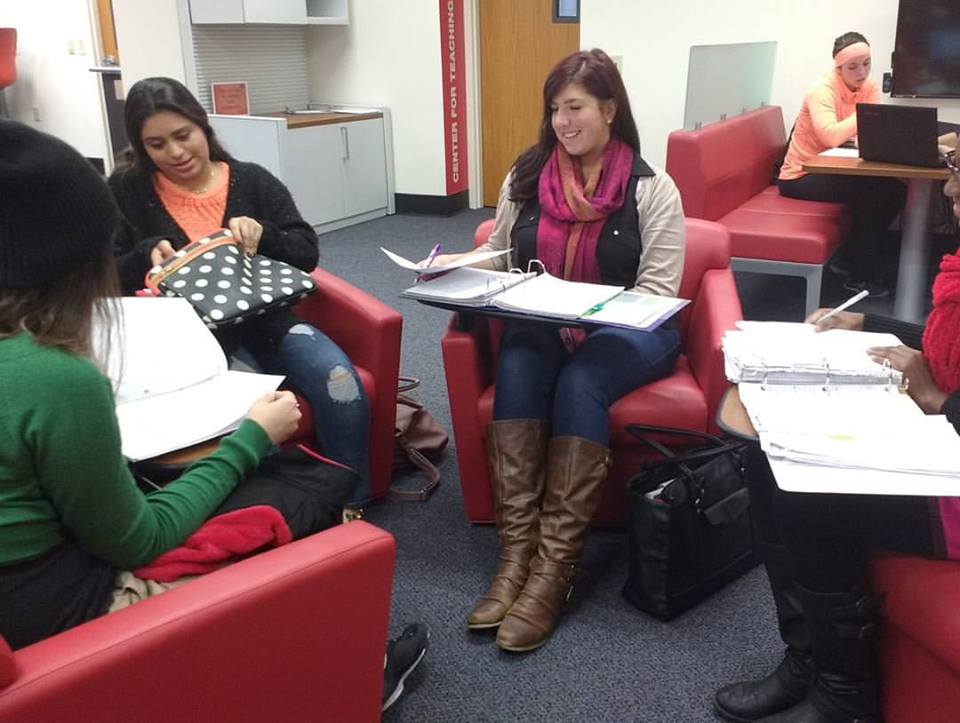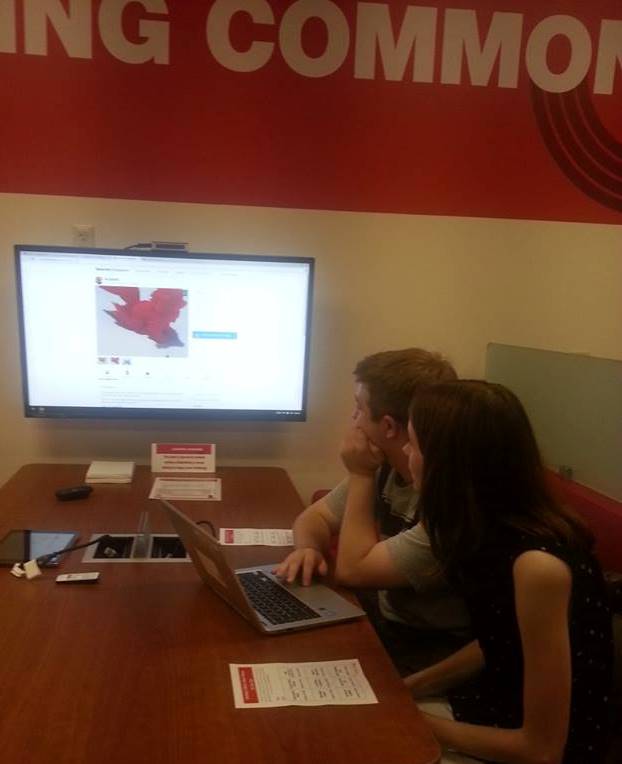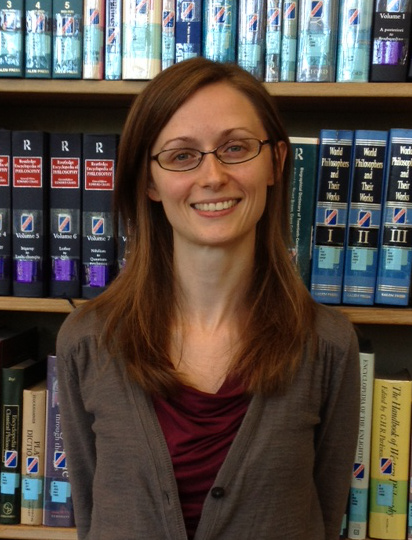By Heather Cook
The new Jennings Library Learning Commons opened at Caldwell University this fall with an open house celebration for faculty, staff, and students on September 2, 2015. This new space is designed for collaboration and enables students to study in groups and receive research assistance from multiple sources, including librarians and professional writing tutors.
 In Libraries Designed for Learning Bennett (2003) describes the underlying theory of the learning commons model, “The core activity of a learning commons... [is] the collaborative learning by which students turn information into knowledge and sometimes into wisdom” (p. 38). The learning commons brings together multiple support services (e.g. information literacy support and writing support), access to technology, and a layout conducive to collaborative group learning and knowledge creation (Heitsch & Holley, 2011).
In Libraries Designed for Learning Bennett (2003) describes the underlying theory of the learning commons model, “The core activity of a learning commons... [is] the collaborative learning by which students turn information into knowledge and sometimes into wisdom” (p. 38). The learning commons brings together multiple support services (e.g. information literacy support and writing support), access to technology, and a layout conducive to collaborative group learning and knowledge creation (Heitsch & Holley, 2011).
The Jennings Library at Caldwell University embraced the learning commons model to expand student space in the library. This model was chosen to support the increasingly collaborative nature of student learning and for its ability to house multiple services in one location.
Dr. Nancy J. Becker, the Executive Director of the Jennings Library and Assistant to the President for Special Projects, spearheaded this project. The implementation of the learning commons required thorough planning including finding space, designing the layout, choosing complementary furniture, discovering innovative technology, and partnering with other campus departments. The construction and remodel was made possible with funds from the Building Our Future General Obligation Bond Act (the GO Bond Act), which was signed into law by Governor Christie in 2012.
Finding space for new areas in any library can be difficult. The Jennings Library decided to repurpose space to house the Learning Commons. Two print periodical storage rooms, containing over 600 printed journals, were designated for the Learning Commons. Starting in Fall 2013, the Electronic Resources Librarian began a thorough analysis of the library’s journal collection. During the Spring 2014 semester, Jennings librarians carefully reviewed the periodical holdings and made informed decisions by title as to what needed to be maintained in print and what was no longer essential to the collection. Some criteria for deaccessioning the periodicals included importance to the discipline, relevance for graduate and doctoral programs, and availability online or through interlibrary loan. The periodicals earmarked for discard were offered first to Caldwell University faculty, then the campus community, and finally more than 20 boxes of journals were sent to JSTOR to be digitized and archived.
 In Fall 2014, maintenance cleared out the periodical storage rooms of any remaining periodicals and construction began. Walls were demolished, the electric and lighting were upgraded, and the area was painted and carpeted.
In Fall 2014, maintenance cleared out the periodical storage rooms of any remaining periodicals and construction began. Walls were demolished, the electric and lighting were upgraded, and the area was painted and carpeted.
With the construction underway it was time to think about furniture. With support for collaboration in mind, comfortable chairs with rotating desk arms that students can easily rearrange and three study booths that can accommodate up to 6 students were selected. Furthermore, an area modeled after Apple’s Genius Bar for students to obtain research and writing assistance was created with a high counter and chairs. Inspirational quotes gathered from throughout history and across disciplines highlighting collaboration were installed on the walls to complement the space.
Collaborative technology was a primary goal for the space. The three collaborative study booths are a highlight of the Learning Commons. Each booth is equipped with a display screen that can connect to up four devices simultaneously for collaborative work. Initially, a standalone unit was considered for the display screens and device connection but this option was cost prohibitive. Fortunately, our IT department discovered a cost effective solution to make the collaborative study booths a reality. Rather than the standalone unit, an Etekcity HDMI switch box and four HDMI cables were purchased for each study booth. The HDMI switch box connects to the display board and to the four HDMI cables. The HDMI cables are threaded through the table allowing the students to select a cable and connect it to a device. Students can use their own laptops or iPads to toggle between up to four devices. The individual screens can be displayed by using a remote control. If they do not have a device, students can check out an iPad Air or Chromebook in the Learning Commons to connect to the display screens in the study booths.
Partnering with other departments was another central idea of the Learning Commons and collaboration with the Writing Center was a natural fit. We began with a writing tutor in the Learning Commons twice a week from 4-8 p.m. The service was an immediate success and the availability of the writing tutor was doubled after the first two weeks.
 Another partner of the Learning Commons is the Faculty Center for Teaching and Learning (FCTL). A new space for the FCTL opened this fall adjacent to the Learning Commons. This space provides faculty with an area to learn, experiment, and meet to discuss technology and teaching pedagogy. The proximity of the FCTL to the Learning Commons was essential to the design of the space to foster a connection between faculty and students.
Another partner of the Learning Commons is the Faculty Center for Teaching and Learning (FCTL). A new space for the FCTL opened this fall adjacent to the Learning Commons. This space provides faculty with an area to learn, experiment, and meet to discuss technology and teaching pedagogy. The proximity of the FCTL to the Learning Commons was essential to the design of the space to foster a connection between faculty and students.
This new collaborative study space is only a few weeks old, but is already one of the most popular areas in the library. Students are making the Learning Commons their own by combining the furniture and pulling up a moveable chair to add an extra student in the study booths. Overwhelmingly positive feedback has come both from the writing tutors and students about the new partnership with the Writing Center. Faculty members walk through the Learning Commons to reach the FCTL providing an opportunity for spontaneous interaction between faculty and students. The learning commons model has expanded the partnerships of the library and increased the services located within the library. It has been an exciting journey and a positive addition to the Jennings Library and to the Caldwell University campus community.
References:
Bennett, S. (2003). Libraries Designed for Learning. Washington, D.C: Council on Library and Information Resources.
Heitsch, E. & Holley, R.P. (2011). The Information and learning commons: Some reflections. New Review of Academic Leadership, 17, 64-77. doi:10.1080/13614533.2011.547416
 Heather Cook is the Learning Commons Librarian at Caldwell University. You can reach her at hcook@caldwell.edu.
Heather Cook is the Learning Commons Librarian at Caldwell University. You can reach her at hcook@caldwell.edu.
